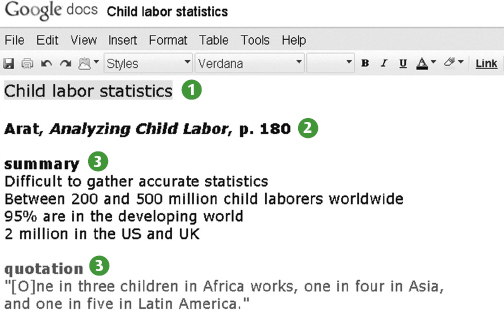14f Take notes and annotate sources.
Note-taking methods vary greatly from one researcher to another, so you may decide to use a computer file, a notebook, or index cards. Regardless of the method, however, you should (1) record enough information to help you recall the major points of the source; (2) put the information in the form in which you are most likely to incorporate it into your research essay, whether a summary, a paraphrase, or a quotation; and (3) note all the information you will need to cite the source accurately. The following example shows the major items a note should include:
Elements of an Accurate Note

 Use a subject heading. Label each note with a brief but descriptive subject heading so that you can group similar subtopics together.
Use a subject heading. Label each note with a brief but descriptive subject heading so that you can group similar subtopics together.
 Identify the source. List the author’s name and a shortened title of the source, and a page number, if available. Your working-bibliography entry (14b) for the source will contain the full bibliographic information, so you don’t need to repeat it in each note.
Identify the source. List the author’s name and a shortened title of the source, and a page number, if available. Your working-bibliography entry (14b) for the source will contain the full bibliographic information, so you don’t need to repeat it in each note.
 Indicate whether the note is a direct quotation, paraphrase, or summary. Make sure quotations are copied accurately. Put square brackets around any change you make, and use ellipses if you omit material.
Indicate whether the note is a direct quotation, paraphrase, or summary. Make sure quotations are copied accurately. Put square brackets around any change you make, and use ellipses if you omit material.
Taking complete notes will help you digest the source information as you read and incorporate the material into your text without inadvertently plagiarizing the source (see Chapter 15). Be sure to reread each note carefully, and recheck it against the source to make sure quotations, statistics, and specific facts are accurate.
Student Writing >: Synthesis project, Caroline Warner